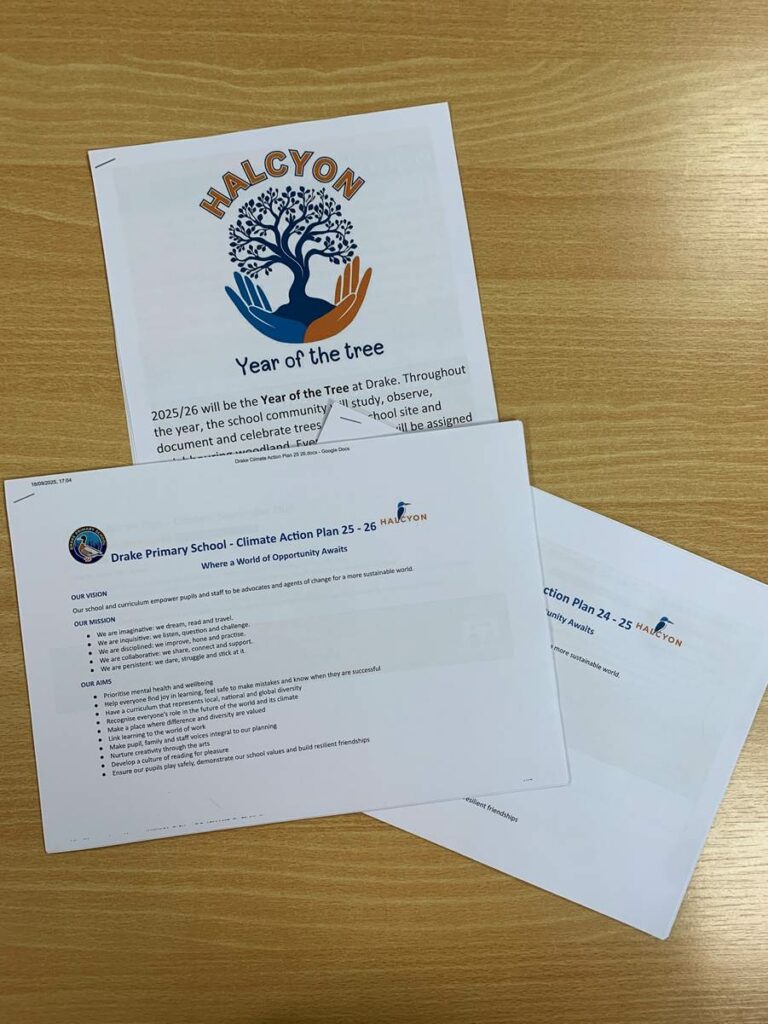Drake Primary’s Growing Sustainability Journey (Part 2)
Last year, we shared the story of Drake Primary School’s ambitious sustainability journey—how a small school in Thetford was embedding climate action into its culture. One year later, we returned to see how those plans have blossomed. We spent the day exploring the site, meeting staff and pupils, and hearing about their next big chapter.
One Year On: Drake Primary’s Growing Sustainability Journey
Kit Marie Rackley (Climate Ambassadors East of England Regional Hub Manager, UEA) and Jenna Gilmour (National Education Nature Park East, RHS), October 2025
From Vision to Reality
After initial visits from the Department for Education Sustainability Support Programme “sister projects” – Climate Ambassadors, National Education Nature Park and Let’s Go Zero, Drake produced a clear Climate Action Plan and a strong sense of purpose. Now, those ideas have taken root—literally. The school grounds are alive with new habitats and green spaces:
- A wetland and pond area buzzing with life.
- Hedgerows and trees providing shelter and food for wildlife.
- An allotment where pupils learn to grow their own produce.
- Plus, wider sustainability measures like solar panels and even electric minibuses.



Dr Jess Tipton, Head of the National Education Nature Park based at the Natural History Museum (lead delivery organisation working with Royal Horticultural Society and others), captured the spirit of the day:
“It was wonderful to visit Drake Primary and see how many habitats have been improved and installed on the site, ranging from a wetland and pond area to lots of hedges, trees and even an allotment, alongside wider sustainability measures like solar panels and electric minibuses. The children were so comfortable being outside and were very knowledgeable about habitats and species, even telling me that one of their ash trees is healthy so may be resistant to ash dieback. It was inspiring to hear from the sustainability leads and SLT about all the thoughtful and creative work being done to embed climate and sustainability through the curriculum in a way that doesn’t overwhelm their colleagues, takes care to address any eco-anxiety and ensures all their students leave school knowing about the issues and solutions.”
Pupils Leading the Way
One of the most striking things about our visit was how at home the pupils were outdoors. They confidently identified tree species, explained the importance of biodiversity, and even discussed the challenges of ash dieback.
This is what climate education looks like when it’s embedded across the curriculum: knowledge, connection, and action.



Next Chapter: The Year of the Tree
Drake isn’t stopping here. For 2025/26, they’ve announced an exciting whole-school initiative: The Year of the Tree.
- Each year group will adopt a tree, exploring it through science, art, and creative projects.
- The Halcyon Forest Project will launch, inspired by a challenge from Chris Packham. Every pupil will name, plant, and care for their own tree—creating a living legacy for the school.
- The year will culminate in a Sustainability Showcase at the Royal Norfolk Show, where pupils’ work will take centre stage.
This isn’t just about trees. It’s about deepening nature connection, supporting wellbeing, and embedding sustainability in a way that excites and empowers.


Why It Matters
Drake’s approach is thoughtful and inclusive. They’ve completed the Climate Adapted Pathways for Education course, embedded climate education without overwhelming staff and taken care to address eco-anxiety. Their story shows what’s possible when sustainability becomes part of a school’s culture—not an add-on, but a shared journey.
Follow Their Journey
Drake Primary Sustainability Page and Climate Action Plan
- Original Case Study on the Nature Park Website
